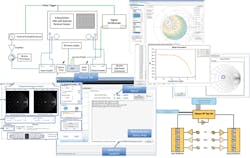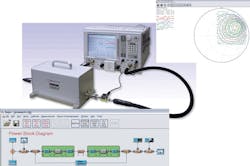Characterization Softwares For Your RF/Microwave Devices
This file type includes high resolution graphics and schematics when applicable.
The task of testing and characterizing RF/microwave/millimeter-wave devices is growing increasingly more complex and time consuming. These new devices need to be characterized so that statistical models can be developed for sophisticated system and circuit design software. With such software, large portions of lag can be shaved from the design cycle. The models also allow thorough testing for manufacturing/statistical analysis.
Because these devices continue to be integrated into smaller, denser packages with higher power densities and additional features, probing by hand is often impractical. To surmount these test challenges and ensure a high quality of model generation, several companies have created software-enhanced test systems. These systems (which are listed below alphabetically according to the company name) provide automation, ease of testing, data analysis, data management, or even model development.
Auriga Wizard-based Integrated Development Environment (WIDE)
The Auriga Component Test System (CTS-4) uses a combination of third-party measurement hardware to enable faster speeds and greater accuracy for in-depth RF/microwave measurements. As a fully automated test system, the CTS-4 is designed to provide multiple-measurement testing in low- to high-volume development and manufacturing. Auriga’s CTS-4 is designed to test the following: base stations; local multipoint distribution systems (LMDSs); multichannel multipoint distribution systems (MMDSs) for customer premise equipment (CPE)--formerly known as broadband radio service or wireless cable; and transmit and receive modules for commercial and military modules or monolithic microwave integrated circuits (MMICs).
The software backbone of the CTS-4 is the Auriga WIDE. The goal of the WIDE environment is to enable skilled and unskilled users to develop scripts for complex test routines that can even run as standalone programs. To accomplish this task, the wizard provides many intuitive measurements, control options, and a library of pre-coded plug-and-play modules. The WIDE can be used for research and development or manufacturing environments to test continuity between development and production environments.
Boonton Amplifier Test Bench
Boonton’s Amplifier Test Bench is freeware designed to aid in the development or production test of amplifiers, filters, and continuous/pulsed/random signals. While coupled with power sensors to measure the input and output power of the device under test (DUT), this software can analyze and generate plots on gain over frequency and power in addition to providing voltage-standing-wave-ratio (VSWR) measurements. Boonton’s Amplifier Test Bench is geared toward working with precision peak power equipment, which can more accurately measure signals to improve the performance optimization of amplifiers or filters. Note that the company, which is part of the Wireless Telecom Group, provides this free software as a service to the industry, but does not provide technical support for it.
Focus Device Characterization Suite (FDCS)
Focus Microwaves’ FDCS is actually a range of software packages that support the detailed characterization of key device parameters. FDCS is composed of a graphics tool, GraphEX, which supports the processing of x-y plots, current-voltage (IV) data, S-parameters, and many more characterization data plots. It also enables file conversion to common formats like Keysight’s Advanced Design System (ADS), Keysight’s Genesys, NI/AWR’s Microwave Office, and CST’s Microwave Suite. A tuner calibration and control package, CalEX, performs standard, thu-reflect-line (TRL), and three termination S-parameter measurements, as well as tuner in-situ calibration.
A load-pull package also is included. Dubbed LPEx, it is capable of input power, output power, gamma, gain, and more. The NPEx suite enables noise-parameter measurements. It has been installed on systems that cover 0.3 to 67.0 GHz. Pulsed signals are handled by the MPIV package, which enables standalone pulsed current-voltage (IV) projects, pulsed DC biasing, and pulsed current-voltage curves.
Keithley Automated Characterization Suite (ACS)
Keithley’s ACS is designed to create and manage a wide variety of test and measurement results for modern discrete semiconductor components and devices with semi-automatic or fully autonomous probes. The software is capable of in-depth testing and parameter extraction. It offers three levels of software geared toward different users. The ACS Basic Edition is designed for manual or single device testing, while the ACS Standard Edition is compatible with multi-DUT testing and even wafer-level-reliability (WLR) testing with the ACS-2600-RTM option. On-wafer die or known-good-die (KGD) testing functionality also is offered to speed testing throughput with multi-DUT statistics and binning analysis during run-time.
The ACS suite also supports two devices: the 4200-SCS Parameter Analyzer and the S500 Integrated Test System. The 4200-SCS is an integrated parameter analyzer based on a modular configuration for the electrical characterization testing of processes, semiconductor devices, and materials. This analyzer is capable of measuring standard IV and capacitance-voltage (CV) measurement sweeps, as well as ultra-fast pulsed IV, waveform capture, and transient IV. The S500 is an integrated and configurable instrument-based test system. It is geared toward device, wafer, and cassette-level characterization. The test system uses Keithley’s TSP-link technology backplane for high-speed measurement throughput.
This file type includes high resolution graphics and schematics when applicable.
Maury Microwave Automated Tuner System (ATS)
This file type includes high resolution graphics and schematics when applicable.
To increase the comprehensiveness and usability of its ATS RF/microwave device-characterization software suite, Maury Microwave has released its fifth version (ATSv5). Among the many measurements that can be performed with ATSv5 are S/X, power, and noise parameters as well as intermodulation distortion (IMD), harmonics, and other key device characteristics. The test results recorded in the ATSv5 environment can be ported to Keysight’s ADS for simulation. They also can be ported to Maury Microwaves’ dynamic-link library (DLL) for use with ATS hardware, which boasts custom test and measurement applications. There are currently 15 ATSv5 software suite models for different applications ranging from active load pull to DC IV curve options.
The first two software-suite models support power characterization and noise characterization. They can be purchased in a combined package. Another package accounts for intermodulation distortion, adjacent-channel power, and error vector magnitude. There are several models for programmers, system control, and tuner library options. Lastly, the software suite has models that enable harmonic source/load pull, fixture characterization, and tuner characterization.
Mesuro VITESSE, WaveForm, and Cardiff Model Lite
Mesuro offers RF device-characterization software to aid with load-pull testing, device process analysis, power-amplifier (PA) design, and model development. The load-pull solution, VITESSE, uses a vector receiver approach to enable engineers to perform calibrated gamma and power measurements. Mesuro’s WaveForm solution couples with patented hardware, a radio-frequency test-stand (RFTS)/multiplexer assembly, and other test equipment to make terminal voltage and current measurements in real time, delivering feedback to discover optimum performance.
To provide high-quality models, large-signal parameters are used with a polyharmonic, distortion-based, behavioral-model formulation using the harmonic superposition principle in the Cardiff Model Lite software. This software offers calibration, characterization setups, and measurement configurations to ensure that all necessary device parameters are provided. As a result, the device model can be extracted even under RF and DC pulse conditions.
R.A. Wood Associates Painless Extraction and RFSpecTest
R.A. Wood Associates uses the graphical programming software language, NI LabView, to construct advanced and even automated RF/microwave testing programs. For example, Painless Extraction automates the extraction of data from a network analyzer to a host computer for analysis. Currently, several Keysight 8000-series network analyzers are supported with the potential for additional hardware support. The files, which are saved using S2P format, can be read by the program for statistical analysis. For RF spectral testing, R.A. Wood Associates provides RFSpecTest. This software performs the multi-component testing of RF/microwave devices for gain, gain compression, isolation, intermodulation distortion (IMD), amplitude, return loss, VSWR, and leakage tests.
National Instruments LabVIEW and LabWindows/CVI
National Instruments’ LabVIEW and LabWindows/CVI are programming and developing environments that can be used to control, acquire, and process data from a variety of hardware and software platforms. NI LabVIEW uses a graphical interface for acquiring data, processing signals, and automating test/validation systems. It also handles instruments control and embedded monitoring/control. The LabVIEW graphical user interface works to simplify programming development and interaction for users who are interfacing with hardware or data.
For its part, NI’s LabWindows/CVI provides an American National Standards Institute (ANSI) C integrated development environment (IDE) and engineering toolbox for functions that are similar to those handled by LabVIEW. Both software environments are commonly paired with NI test equipment in modular packages, as well as other vendors’ test equipment, to automate/simplify test routines and characterize/distribute test data.
This file type includes high resolution graphics and schematics when applicable.
About the Author
Jean-Jacques DeLisle
Jean-Jacques graduated from the Rochester Institute of Technology, where he completed his Master of Science in Electrical Engineering. In his studies, Jean-Jacques focused on Control Systems Design, Mixed-Signal IC Design, and RF Design. His research focus was in smart-sensor platform design for RF connector applications for the telecommunications industry. During his research, Jean-Jacques developed a passion for the field of RF/microwaves and expanded his knowledge by doing R&D for the telecommunications industry.



